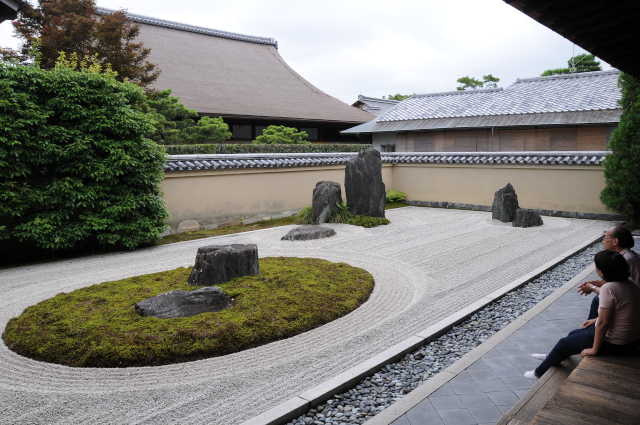In the north of Kyoto lies Daitoku-ji, the “Temple of Great Virtue”. It is not one single temple, but rather a sprawling complex of 22 subtemples located on 27 hectares of land. Daitoku-ji belongs to the Rinzai sect of Zen Buddhism, and in fact it is the headquarters of its own branch of Buddhism.
It was founded around 1315 by the monk Daito Kokushi with imperial support as a small monastery. Like many buildings in Kyoto, the temple was destroyed during the Onin Wars of the 15th century but was rebuilt later. Therefore, the main buildings of Daitoku-ji – altogether National Treasures – date back only to the 15th century.

The main buildings of the temple are the vermilion Sanmon Gate, the Buddha and Dharma Halls, the Abbot’s Quarters, as well as a Bathhouse and a Sutra Library. In front of the Sanmon Gate lies the Chokushimon (Imperial Messenger Gate) that was moved here from the Imperial Palace.
These buildings, although they are not usually accessible, can all be viewed from the main path that leads through the temple and is lined with large pine trees. Smaller paths lead to the gates of the different subtemples that are all more or less independent and were added to the complex over time, often founded by noble families.
Daitoku-ji saw a boost in prominence in the late 16th century when Hideyoshi donated land and money and had the remains of Oda Nobunaga and his closest family buried in the specially founded subtemple Soken-in. I’ve posted about Soken-in before, to my mind it’s not the most exciting of all the temples of the complex.

Daitoku-ji is also connected to tea master Sen-no-Rikyu, who had the vermillion Sanmon Gate renovated. A popular story has it that he placed an image of himself in the second floor of this gate, which enraged Hideyoshi so much that he ordered him to commit seppuku.
To this day, the whole temple complex is a living monastery, where monks learn, teach, and practice Buddhism. Therefore, many of the subtemples are generally not accessible to the public, except for short viewings during select times.

One of the most important subtemples is Shinju-an, which was founded in 1491 in memory of Ikkyu Sojun, who was essential for the rebuilding of Daitoku-ji. He was a rather eccentric priest, and Shinju-an treasures his memory with fusuma paintings by contemporary artists. It is also the place where the fathers of modern Noh, Kan-ami and Ze-ami, are buried.

The subtemple Daisen-in is one of the most important Zen temples of all Kyoto. It has fusuma paintings by Zen monk Soami, but the important thing to see is the dry landscape garden that stems from the Muromachi era. It depicts the Chinese idea of paradise, and its pebbly waters flow all around the main hall.
Juko-in is the family temple for Sen-no-Rikyu and his descendants, and thus plays an important role in Kyoto’s tea world. All the heads of the three main family branches of tea ceremony are buried here. Juko-in is also famous for its16th-century fusuma paintings by Kano Eitoku.

Most of the subtemples of Daitoku-ji hold important treasures of Japanese history, may it be their buildings themselves, their fusuma paintings, or Buddhist statues or other relics. While they may seem all alike to the casual observer, it is worth looking at the little details that make all the difference.
As mentioned, the subtemples are only accessible at select times. On most days, 2-4 subtemples are open to the public. Daisen-in, Zuiho-in, Koto-in, and Ryogen-in are open throughout the year, many others for short periods in spring and autumn or during special occasions. This makes Daitoku-ji one of the quieter places to visit in Kyoto and fun to explore.
